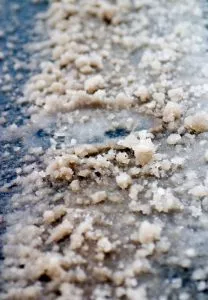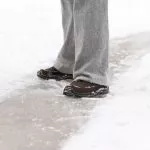Deicers are a necessity of life during the Ontario winter. While a cold, sunny day after a snowfall may be enough to keep a walk that has been carefully shovelled ice free, most of the time you will need some type of salt or deicer to keep ice from reappearing on the walks and driveways of your clients. Unfortunately, lots of deicers have some kind of negative environmental consequences. Here is what you need to know to make the best decision for the needs of your clients.
The Impact of Salt on the Landscape

If you notice clients with salt burn on their yards in the spring, try using a high calcium lime. That will help it recover, though a better approach is to limit the initial damage.
Liquid Deicers
Generally speaking, liquid deicers are safer for the ecosystem than rock salt. Though they typically contain some type of salt, the concentration is lower than in standard rock salt. With liquid deicers, there will be less salt accumulating in planting beds and along the rim of the lawn. Liquid deicers also work better than rock salt at low temperatures. A small spray pump is the easiest way to apply them.
New Deicing Products

A few ice melters have no salt at all. CMA, calcium magnesium acetate, is one of these. It has minimal environmental impact but, again, is more expensive than salt-based deicers.
Lessen the Negative Effects of Salt

Always apply deicers and rock salt carefully, and don’t use more than needed. Careful application keeps deicer on the pavement where it’s most needed. Lots of damage happens from accidental spreading, splashing and excessive use of deicing products. Being conservative with deicers also saves money.
Environmentally conscious contractors and homeowners will find proper use of the right products is the best way to remove ice without harming the local ecosystem, including ponds, rivers and streams.
Stop by Lane’s Landscaping Supplies to reserve your bulk salt for the winter and keep your clients satisfied and safe from bone-jarring slips.

